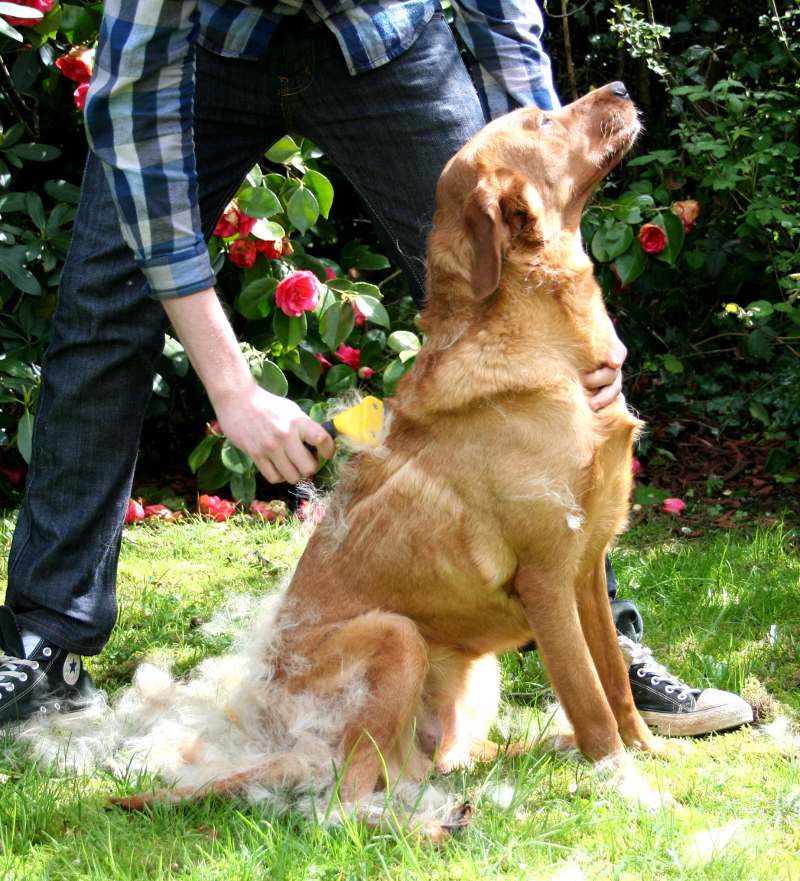Labradors molt more during seasonal changes, typically in spring and fall. Excessive moulting can also indicate stress, poor diet, or skin issues.
Moulting is a natural process for Labradors, reflecting their changing coat needs. As a double-coated breed, they shed fur to adapt to temperature fluctuations. Owners often notice increased shedding during seasonal transitions. Stress, allergies, or an imbalanced diet can also contribute to excessive fur loss.
Regular grooming helps manage shedding and keeps their coat healthy. Understanding the reasons behind your Labrador’s moulting can improve their comfort and well-being. Monitoring their environment and diet will help maintain a healthy coat. Address any concerns with your veterinarian to ensure your furry friend stays happy and healthy.
The Basics Of Labrador Moulting
Labrador Retrievers are known for their friendly nature and beautiful coats. Understanding why they moult is essential for every owner. Moulting is a natural process where dogs shed old hair. It helps them maintain a healthy coat. Several factors influence how much your Labrador moults.
Seasonal Changes And Their Impact
Seasonal changes play a significant role in moulting. Labradors typically experience two main moulting periods each year:
- Spring: They shed their winter coat for lighter fur.
- Fall: They prepare for winter by growing a thicker coat.
During these times, you may notice excessive shedding. The transition in temperature triggers this process. Warm weather encourages more shedding. Keep an eye on your dog during these months.
Age And Health Factors
Age affects how much your Labrador moults. Puppies shed less than adults. Senior dogs may also experience changes in their coat. Health issues can also cause increased moulting.
| Age Group | Shedding Level |
|---|---|
| Puppy (up to 1 year) | Low |
| Adult (1-7 years) | Moderate to High |
| Senior (7+ years) | Variable |
Healthy Labradors have a shiny coat and shed less. Poor diet or illness can increase shedding. Regular vet check-ups help maintain your dog’s health.
Nutritional Influences On Moulting
Diet plays a crucial role in your Labrador’s moulting process. Proper nutrition helps maintain a healthy coat. A balanced diet can reduce excessive shedding. Understanding what to feed your dog is essential.
The Role Of Diet
The right nutrients can greatly impact your dog’s coat health. Focus on these key components:
- Protein: Builds strong hair follicles.
- Omega-3 Fatty Acids: Keeps skin moisturized.
- Vitamins: Supports overall health.
- Minerals: Enhances coat strength.
High-quality dog food often contains these nutrients. Look for foods rich in:
| Nutrient | Benefits |
|---|---|
| Protein | Strengthens hair growth |
| Omega-3 | Reduces inflammation |
| Vitamin A | Promotes skin health |
| Zinc | Prevents hair loss |
Supplements To Reduce Shedding
Sometimes, diet alone isn’t enough. Supplements can help manage shedding. Consider these options:
- Fish Oil: Rich in Omega-3s, great for skin.
- Biotin: Supports hair growth.
- Zinc: Essential for coat health.
- Flaxseed Oil: Another source of Omega-3s.
Before adding supplements, consult your vet. They can recommend the best options for your Labrador. A well-balanced diet and proper supplements can make a big difference.
Grooming Techniques To Manage Moulting
Managing your Labrador’s moulting is essential. Proper grooming techniques can reduce shedding and keep your home cleaner. Regular grooming helps keep your dog’s coat healthy and shiny. Let’s explore effective grooming methods.
Regular Brushing Routines
Establish a consistent brushing schedule. Aim for at least two to three times a week. This routine helps to remove loose hair and prevent matting.
- Brush after walks to remove dirt and debris.
- Brush before bath time to loosen trapped fur.
- Consider daily brushing during heavy moulting seasons.
Make grooming a fun bonding time. Use treats to encourage your dog. Keep sessions short and enjoyable.
Best Tools For The Job
Selecting the right tools makes a difference. Here are some recommended grooming tools:
| Tool | Purpose |
|---|---|
| Pin Brush | Good for removing loose hair and dirt. |
| Slicker Brush | Helps with tangles and undercoat removal. |
| Rubber Grooming Mitt | Great for gentle massaging and loosening hair. |
| De-shedding Tool | Effective for managing heavy shedding periods. |
Choose tools that suit your dog’s coat type. Experiment to find what works best. Keep the grooming experience positive and stress-free.

Credit: www.petethevet.com
Environmental Factors Affecting Shedding
Shedding is natural for Labradors. Environmental factors can increase shedding. Understanding these factors helps manage your dog’s coat.
Indoor Vs. Outdoor Living
Indoor living has a different impact than outdoor living. Here’s how:
| Living Environment | Shedding Impact |
|---|---|
| Indoor |
|
| Outdoor |
|
Temperature And Humidity Effects
Temperature and humidity play a big role in shedding. Dogs need to adjust to these changes.
- Hot Weather:
- Dogs shed more to cool off.
- Heat stress can lead to excessive shedding.
- Cold Weather:
- Thicker coats develop in winter.
- Shedding may occur during spring.
- Humidity:
- High humidity keeps skin hydrated.
- Low humidity can dry skin and increase shedding.
Monitor your dog’s environment. Adjust as needed to reduce shedding.
When To Seek Veterinary Advice
Labradors are known for their beautiful coats. Shedding is normal, but excessive moulting can signal issues. Knowing when to seek veterinary advice is crucial for your dog’s health.
Signs Of Unusual Shedding
Watch for these signs of unusual shedding:
- Patchy bald spots: These may indicate skin problems.
- Skin redness or irritation: This can suggest allergies or infections.
- Increased scratching: Frequent scratching may point to parasites.
- Unpleasant odor: Foul smells can indicate skin infections.
- Changes in appetite or behavior: This can signal discomfort or illness.
Health Conditions Leading To Excessive Moulting
Several health conditions can cause excessive moulting:
| Condition | Description |
|---|---|
| Allergies | Food or environmental allergies can lead to increased shedding. |
| Parasites | Ticks and fleas cause irritation and more hair loss. |
| Hormonal imbalances | Conditions like hypothyroidism can affect coat health. |
| Infections | Bacterial or fungal infections can lead to hair loss. |
| Stress or anxiety | Emotional distress can cause excessive shedding. |
Consult a veterinarian if you notice any of these issues. Early intervention can help ensure your Labrador stays healthy and happy.

Credit: www.thelabradorsite.com

Credit: www.thelabradorsite.com
Conclusion
Moulting is a normal part of a Labrador’s life. Understanding the reasons behind it can help you manage shedding better. Seasonal changes, health issues, or diet can all play a role. Regular grooming and a balanced diet can minimize excessive shedding.
Keep your Labrador healthy and happy by addressing moulting concerns effectively.
